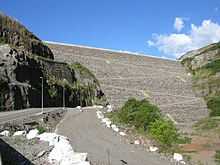Campos Novos Dam
| Campos Novos Dam | |
|---|---|
 | |
 | |
| Official name | Barragem de Campos Novos |
| Location | Campos Novos, Brazil |
| Coordinates | 27°36′15″S 51°19′35″W / 27.60417°S 51.32639°WCoordinates: 27°36′15″S 51°19′35″W / 27.60417°S 51.32639°W |
| Construction began | August 2001 |
| Opening date | July 2006 |
| Construction cost | US$671 million |
| Dam and spillways | |
| Type of dam | Rock-fill dam |
| Impounds | Canoas River |
| Length | 600 m (2,000 ft) |
| Height | 202 m (663 ft) |
| Power station | |
| Installed capacity | 880 MW |
The Campos Novos Dam (also known as Barragem de Campos Novos locally) is a hydroelectric dam in Santa Catarina province in southern Brazil. In 2006, at 200m dam height, it was regarded as the third highest dam of this type (concrete-faced rockfill dam or CFRD) in the world, but, in June 2006, the water which it held back ran out following a break in the dam wall.
Built at the cost of $671 million USD, it is located on the Canoas River, Brazil. It is part of a hydro-electric complex intended to provide 880 MW. A second dam is below this one, and together they can hold a little more than 2 cubic kilometers of water.
Ownership and construction
Campos Novos' 35 years build and operate concession was awarded in 1998. It is owned by Enercan, a consortium made up of Brazilian power company CPFL Energia with 48.7%, Brazilian aluminium maker CBA with 22.7%, metallurgy company CNT with 20%, state-controlled companies Rio Grande do Sul with 6.5% and Santa Catarina Celesc with 2%.
The dam builder was a consortium led by Brazilian construction company Camargo Correa and engineering consultants Engevix. Funding is by Inter-American Development Bank and Brazilian state-owned National Bank for Economic and Social Development.
Cracks
A major break caused the water to begin to run out, after a tunnel collapsed on 20 June 2006. The exact reasons for the cracking were unknown in July 2006, however it has been revealed that patches were begun on another tunnel in October 2005 before the recent tunnel failure.[1][2]
Since the dam failure, a full inquiry for the reasons behind the cracks has been done, and a time-line of the dam's progression towards failure has been completed.[3] Following this discovery, hidden by the partners of the project, it appeared that these companies had maltreated the local populations. An investigation into the human rights violations was launched by United Nations Organisation.[2]
Camargo Corrêa re-plugged the tunnels in November 2006 and the reservoir was refilled by 1 March 2007. The last of the three generators went on-line on 30 April 2007.
Gallery
-

Detour of the Canoas River, April 2005
-

3 pipes on the left to the turbines, 4 water outlets on the right, April 2005
-

inside the future storage lake, 3 months before damming
-

storage lake, March 2008
-

lower side of the power station, March 2008
-

March 2008
See also
- List of hydroelectric power stations
- List of power stations in Brazil
- List of world's tallest dams
References
- ↑ Enormous new dam fails in Brazil, New Scientist, 2006-07-08
- ↑ 2.0 2.1 Giant cracks appear in new Brazilian dam, Environment News Service, 2006-06-29
- ↑ Inquiry and Timeline